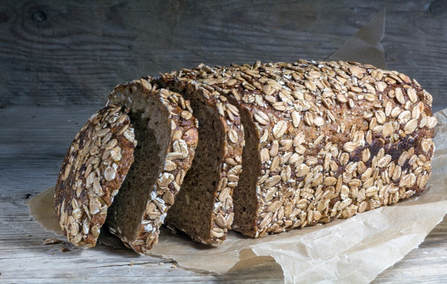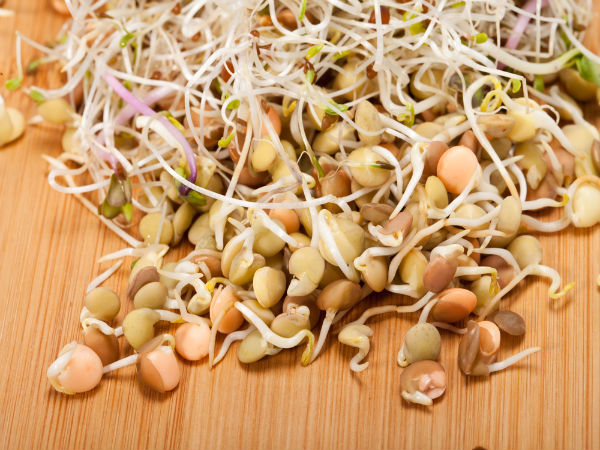 Relish a Pair of Sprouted-grain Sandwich Relish a Pair of Sprouted-grain Sandwich Whole grains, one of the five food groups are indispensable for a healthy life. Refined flour foods have been replaced with whole wheat items in our kitchen cabinets. Our ancient millets occupy a safe place in our everyday meal unperturbed by the presence of other food ingredients. Quinoa is regarded as the magic food by health fanatics and fitness freaks. Beyond all these are our very own sprouted grains. Sprouted Grains According to acclaimed registered dietitian nutritionists, sprouted grains are nothing but whole-grain seeds that have just begun to sprout. Grains are seeds of plants, mostly cereal grasses. The tiny grain is packed with potency to grow into a new plant via its three important edible parts-the germ, endosperm and bran. The germ is the plant embryo that feeds on the starchy endosperm as it grows. The bran contains many other nutrients which along with the inedible husk protect the grain seeds until they are ready to grow. Until all this happen, the seed survives on built-in growth inhibitors to prevent germinating until conditions such as temperature and moisture are set right. In order to get the right sprout growth, whole grains are soaked overnight in water and placed under controlled environments that have the right kind of temperature and warmth suitable for sprouting. We can do it at home (most people use a cloth to tie up the grains and leave them untouched for a couple of days or use a vented jar) or do it commercially at food manufacturing plants. The germination process yields the desired sprouted grains at the right temperature and moisture and this breaks down nutrients in the grain to break down into simpler nutrients used by the growing sprout. Sprouting until the sprout is as long as the grain kernel is good for consumption otherwise the healthy sprout grows indefinitely even as big as a new grass which becomes inedible for human consumption. Sprouted Grains Any Better than Whole Grains? If we ask the same question to our shopkeepers and vendors, we can be sure of an affirmative reply. Of course, each of us have to sell our ware and indeed, sprouted grains have numerous health benefits but everything has its own pros and cons.
Research dating back to as early as the 1940s show that sprouted seeds contain up to 300% vitamin A and more than 500% vitamin C. Another study in 2012 found that sprouted wheat contained higher levels of fiber, amino acids and antioxidants just 48 hours after sprouting compared to unsprouted wheat. The nutritional effect of sprouted grains grows a tad more when it comes to nutrients such as vitamins, minerals, antioxidants and soluble fiber but this advantage is counterbalanced by a decrease in total dry matter, proteins and insoluble fiber which remains as the benchmark of whole grain. Fiber plays a key role in maintaining our body in good health and for more details about it, please visit the website www.firsteatright.com. Supportive for Pathogens The warm and moist climate required for sprouting are ideal for bacterial growth of pathogens and hence, sprouts should never be served raw to children, elderly population, pregnant women and those with compromised immune function. It is better to mash them into a paste or cook them before adding to a meal. Home-produced or commercially purchased, any sprout should be refrigerated. We can eat them raw, but it is always better to cook them as these little chaps have been associated with more than 40 foodborne illnesses and are among the top 10 foods that cause foodborne illness. Comments are closed.
|
AVOID FRAUD. EAT SMART.+91 7846 800 800
AuthorDietitian & Nutritionist Dr. Nafeesa Imteyaz. Archives
November 2022
Categories
All
Dr. Nafeesa's Blog @blogspot |
- Home
- Written Testimonials
- Consult
- Clinics
- Blogs
-
Diet & Nutrition
- Diabetes Reversal
- IVF IUI not needed for PCOS PCOD Infertility
-
Medical Nutrition
>
-
Disease & Conditions
>
- Infertility | PCOS
- Diabetes Mellitus
- Cholesterol
- Hypothyroid
- Kidney Problems
- Hypertension
- Cardiovascular Diseases
- Liver Diseases
- Gastro intestinal disorder
- Cancer
- Metabolic Disorders
- Orthopedic Disorders
- Eating Disorders
- Dietary Recall
- Weight Record Filled By Clients
- Online Payment Transaction Details
- Online Clients Weight Check Form
- Our Program Package Service Charges
- Weight Record 2017 Clients
- Measurements sent by Clients
- Terms & Conditions Of Payment
- Thanks. Your Form is Submitted
- Video Testimonials
- Lifestyle & Wellness
- Lifestyle & Wellness Blog
- Allergy & Intolerance
- Weight Loss / Gain
- Weight Loss / Slimming Blog
-
Disease & Conditions
>
- Life Cycle Nutrition >
- Sports Nutrition >
- Integrity in Nutrition
- Knowledge Centre
© COPYRIGHT 2022. ALL RIGHTS RESERVED. FRST HEALTHCARE PVT LTD.
Dr. Nafeesa Imteyaz of First Eat Right clinic, is the Best Dietitian Nutritionist in Bangalore. Best Dietitian Nutritionist in Pune. Best Dietitian Nutritionist in Hyderabad. Best Dietitian Nutritionist in Chennai. Best Dietitian Nutritionist in Mumbai. Best Dietitian Nutritionist in Delhi. Best Dietitian Nutritionist in Kolkata.


